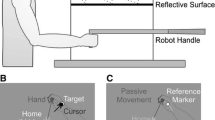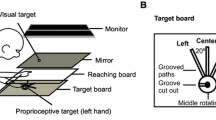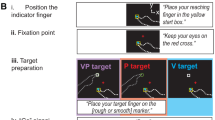Abstract
We have recently shown that visuomotor adaptation following reaches with a misaligned cursor not only induces changes in an individual’s motor output, but their proprioceptive sense of hand position as well. Long-term changes are seen in motor adaptation; however, very little is known about the retention of changes in felt hand position. We sought to evaluate whether this recalibration in proprioception, following visuomotor adaptation, is sufficiently robust to be retained the following day (~24 h later), and if so, to determine its extent. Visuomotor adaptation was induced by having subjects perform reaches to visual targets using a cursor representing their unseen hand, which had been gradually rotated 45° counterclockwise. Motor adaptation and proprioceptive recalibration were determined by assessing subjects’ reach aftereffects and changes in hand bias, respectively. We found that subjects adapted their reaches and recalibrated their sense of hand position following training with a misaligned cursor, as shown in Cressman and Henriques (J Neurophysiol 102:3505–3518, 2009). More importantly, subjects who showed proprioceptive recalibration in the direction of motor adaptation on Day 1 did retain changes in felt hand position and motor adaptation on Day 2. These findings suggest that in addition to motor changes, individuals are capable of retaining sensory changes in proprioception up to 24 h later.




Similar content being viewed by others
References
Bernier PM, Chua R, Franks IM (2005) Is proprioception calibrated during visually guided movements? Exp Brain Res 167:292–296
Berniker M, Kording K (2008) Estimating the sources of motor errors for adaptation and generalization. Nat Neurosci 11:1454–1461
Berniker M, Kording KP (2011) Estimating the relevance of world disturbances to explain savings, interference and long-term motor adaptation effects. PLoS Comput Biol 7:e1002210
Bock O, Schneider S, Bloomberg J (2001) Conditions for interference versus facilitation during sequential sensorimotor adaptation. Exp Brain Res 138:359–365
Brashers-Krug T, Shadmehr R, Bizzi E (1996) Consolidation in human motor memory. Nature 382:252–255
Caithness G, Osu R, Bays P, Chase H, Klassen J, Kawato M, Wolpert DM, Flanagan JR (2004) Failure to consolidate the consolidation theory of learning for sensorimotor adaptation tasks. J Neurosci 24:8662–8671
Clayton HA, Cressman EK, Henriques DY (2013) Proprioceptive sensitivity in Ehlers-Danlos syndrome patients. Exp Brain Res 230:311–321
Cressman EK, Henriques DY (2009) Sensory recalibration of hand position following visuomotor adaptation. J Neurophysiol 102:3505–3518
Cressman EK, Henriques DY (2010a) Generalization patterns for motor and sensory plasticity differ following visuomotor learning. In: Society for neuroscience. San Diego, California
Cressman EK, Henriques DY (2010b) Reach adaptation and proprioceptive recalibration following exposure to misaligned sensory input. J Neurophysiol 103:1888–1895
Cressman EK, Salomonczyk D, Henriques DY (2010) Visuomotor adaptation and proprioceptive recalibration in older adults. Exp Brain Res 205:533–544
Hatada Y, Miall RC, Rossetti Y (2006) Two waves of a long-lasting aftereffect of prism adaptation measured over 7 days. Exp Brain Res 169:417–426
Hay JC, Pick HLJ, Ikeda K (1965) Visual capture produced by prism spectacles. Psychon Sci 2:215–216
Hay JC, Pick Jr, Herbert L (1966) Visual and proprioceptive adaptation to optical displacement of the visual stimulus. J Exp Psychol 71:150–158
Henriques DY, Soechting JF (2003) Bias and sensitivity in the haptic perception of geometry. Exp Brain Res 150:95–108
Jeannerod M (1988) The neural and behavioural organization of goal-directed movements. Oxford University Press, Oxford
Joiner WM, Smith MA (2008) Long-term retention explained by a model of short-term learning in the adaptive control of reaching. J Neurophysiol 100:2948–2955
Jones SA, Cressman EK, Henriques DY (2010) Proprioceptive localization of the left and right hands. Exp Brain Res 204:373–383
Kesten H (1958) Accelerated stochastic approximation. Ann Math Stat 29:41–59
Klassen J, Tong C, Flanagan JR (2005) Learning and recall of incremental kinematic and dynamic sensorimotor transformations. Exp Brain Res 164:250–259
Krakauer JW, Ghilardi MF, Ghez C (1999) Independent learning of internal models for kinematic and dynamic control of reaching. Nat Neurosci 2:1026–1031
Krakauer JW, Pine ZM, Ghilardi MF, Ghez C (2000) Learning of visuomotor transformations for vectorial planning of reaching trajectories. J Neurosci 20:8916–8924
Krakauer JW, Ghez C, Ghilardi MF (2005) Adaptation to visuomotor transformations: consolidation, interference, and forgetting. J Neurosci 25:473–478
Martin TA, Keating JG, Goodkin HP, Bastian AJ, Thach WT (1996) Throwing while looking through prisms. II. Specificity and storage of multiple gaze-throw calibrations. Brain 119(Pt 4):1199–1211
Mostafa AA, Salomonczyk D, Cressman EK, Henriques DY (2014) Intermanual transfer and proprioceptive recalibration following training with translated visual feedback of the hand. Exp Brain Res 232:1639–1651
Ostry DJ, Darainy M, Mattar AA, Wong J, Gribble PL (2010) Somatosensory plasticity and motor learning. J Neurosci 30:5384–5393
Redding GM, Wallace B (2004) First-trial adaptation to prism exposure: artifact of visual capture. J Mot Behav 36:291–304
Redding GM, Rossetti Y, Wallace B (2005) Applications of prism adaptation: a tutorial in theory and method. Neurosci Biobehav Rev 29:431–444
Salomonczyk D, Cressman EK, Henriques DY (2011) Proprioceptive recalibration following prolonged training and increasing distortions in visuomotor adaptation. Neuropsychologia 49:3053–3062
Salomonczyk D, Henriques DY, Cressman EK (2012) Proprioceptive recalibration in the right and left hands following abrupt visuomotor adaptation. Exp Brain Res 217:187–196
Salomonczyk D, Cressman EK, Henriques DY (2013) The role of the cross-sensory error signal in visuomotor adaptation. Exp Brain Res 228:313–325
Shadmehr R, Brashers-Krug T (1997) Functional stages in the formation of human long-term motor memory. J Neurosci 17:409–419
Shadmehr R, Smith MA, Krakauer JW (2010) Error correction, sensory prediction, and adaptation in motor control. Annu Rev Neurosci 33:89–108
Simani MC, McGuire LM, Sabes PN (2007) Visual-shift adaptation is composed of separable sensory and task-dependent effects. J Neurophysiol 98:2827–2841
Smith MA, Ghazizadeh A, Shadmehr R (2006) Interacting adaptive processes with different timescales underlie short-term motor learning. PLoS Biol 4:e179
Synofzik M, Thier P, Lindner A (2006) Internalizing agency of self-action: perception of one’s own hand movements depends on an adaptable prediction about the sensory action outcome. J Neurophysiol 96:1592–1601
Tong C, Wolpert DM, Flanagan JR (2002) Kinematics and dynamics are not represented independently in motor working memory: evidence from an interference study. J Neurosci 22:1108–1113
Treutwein B (1995) Adaptive psychophysical procedures. Vision Res 35:2503–2522
Wang J, Sainburg RL (2005) Adaptation to visuomotor rotations remaps movement vectors, not final positions. J Neurosci 25:4024–4030
Wolpert DM, Miall RC, Kawato M (1998) Internal models in the cerebellum. Trends Cogn Sci 2:338–347
Yamamoto K, Hoffman DS, Strick PL (2006) Rapid and long-lasting plasticity of input-output mapping. J Neurophysiol 96:2797–2801
Acknowledgments
We wish to thank Rozbeh Kamran-Disfani for his assistance with data collection. This research was supported by an NSERC Discovery Grant to DYPH and EKC.
Author information
Authors and Affiliations
Corresponding author
Rights and permissions
About this article
Cite this article
Nourouzpour, N., Salomonczyk, D., Cressman, E.K. et al. Retention of proprioceptive recalibration following visuomotor adaptation. Exp Brain Res 233, 1019–1029 (2015). https://doi.org/10.1007/s00221-014-4176-6
Received:
Accepted:
Published:
Issue Date:
DOI: https://doi.org/10.1007/s00221-014-4176-6




